For Love of Trees

Oak and pine trees, some of the most common trees in our area, are among the keystone species that support the most animal life.
Trees enrich our lives in countless ways. Yet we may not pay them much attention, until they are gone.
A Million Trees in a Single Day
Pioneers in the Nebraska Territory missed the trees they left behind back East. They needed trees for shade from the summer sun, for windbreaks to hold the soil, for fuel and for building materials. They needed trees so much, that Nebraska’s Board of Agriculture planned the first American Arbor Day celebration on April 10th of 1872. A million trees were planted in Nebraska that day.
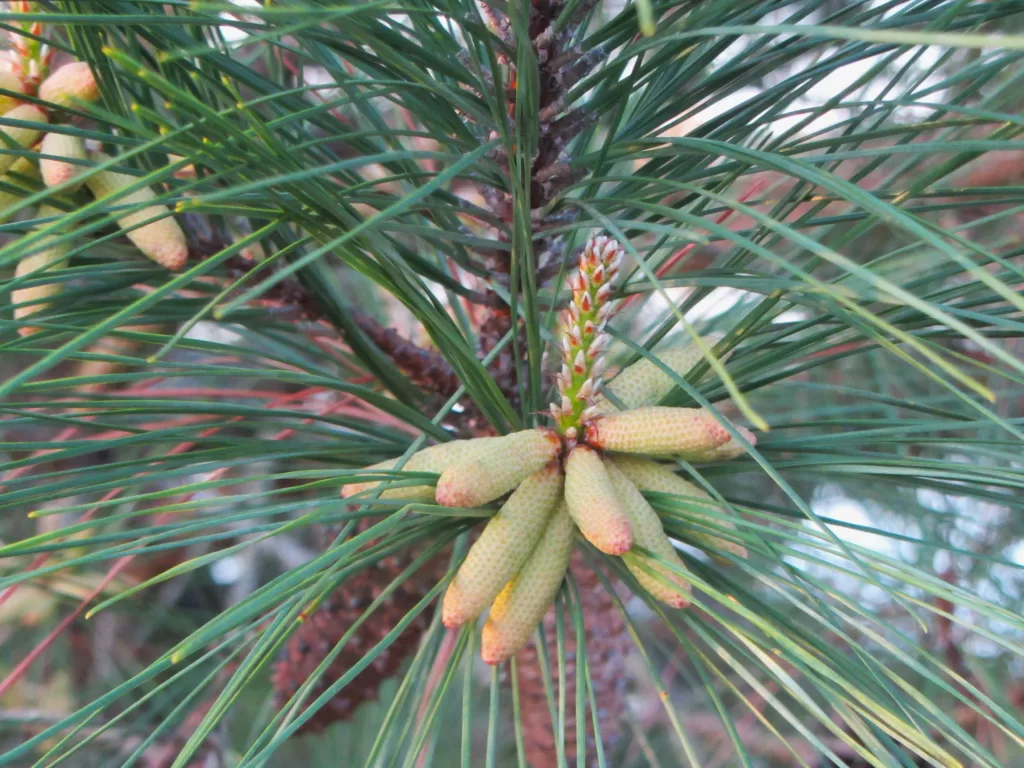
Native Pinus taeda, loblolly pine, late March 2024.
A Good Idea Gains Momentum
In 1883, the American Forestry Association decided to spread the idea of celebrating an ‘Arbor Day’ internationally with visits to Japan, and other countries, to highlight the benefits of planting trees.
By 1885, Arbor Day was proclaimed a legal holiday in Nebraska. At that time there was great concern about the destruction of America’s forests and a growing movement for conservation of unspoiled land. On April 15, 1907, President Teddy Roosevelt issued an “Arbor Day Proclamation to the School Children of the United States.”
By 1920, over 45 states and territories in the United States observed Arbor Day. By the middle of the 20th Century, a long list of nations, including Japan, Australia, Canada, China, Brazil, and Cuba had organized their own Arbor Day festivals. These annual celebrations had an educational component to teach youth about the value of trees.

Native Betula nigra, river birch and loblolly pine trees are among our keystone species. Photo from the Williamsburg Botanical Garden and Freedom Park Arboretum.
Trees Make Us Happy
Recent research has demonstrated the crucial role of trees and forests in people’s happiness. We feel less stressed and live healthier lives when trees grow near our homes. Plant trees, and crime goes down in a community even as the children’s performance in school improves. Plant trees near a hospital, and patients recover faster. All over the world, people seek out trees in parks and public forests to relax and recover from the stress of daily life.
Trees feed, heal and shelter us. They produce the oxygen we breathe as they filter pollutants from the air. Their branches shelter family picnics as they also provide nesting areas for wildlife. They produce edible leaves, berries, nuts, and fruit. People make medicines from the leaves and bark, and use the wood for building shelter, making paper, creating tools, furniture, and a host of items.
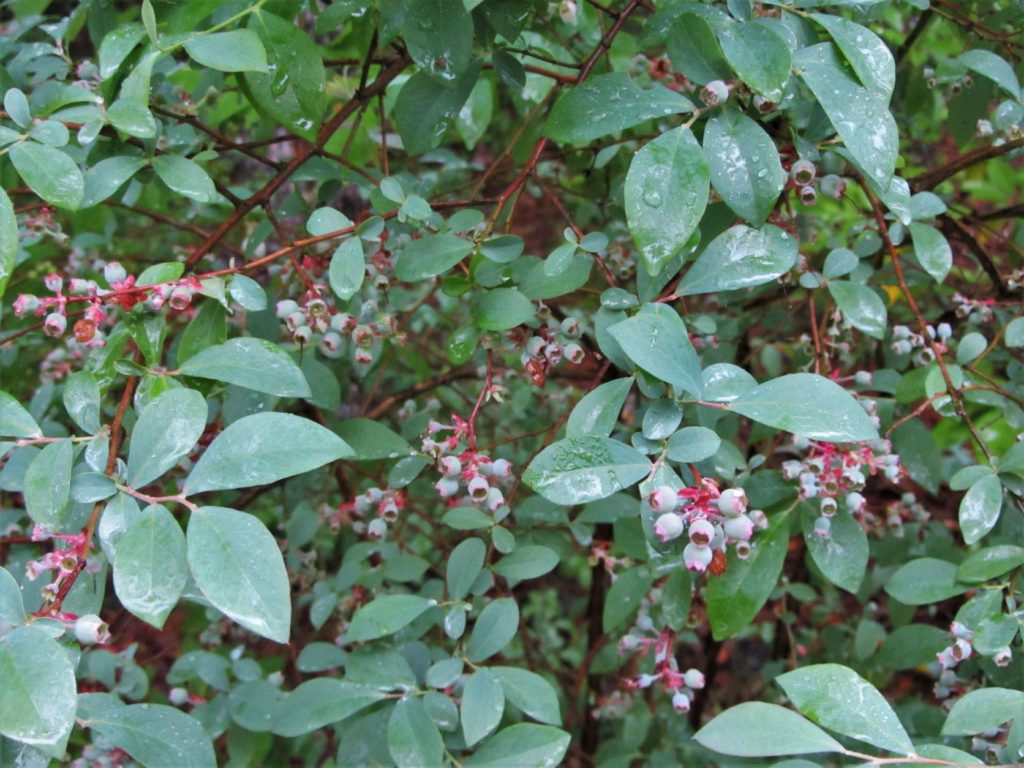
Blueberries, huckleberries, deer berries, and other Vaccinium species support wildlife as host plants, nectar plants and as fruit bearing shrubs. They are a keystone species in our biome.
Supporting the Web of Life
Trees host the larvae of butterflies, beetles, and other insects needed by birds and small animals for food. Certain native trees, likes oaks and black cherries, are keystone species that feed hundreds of different animals. Without them, local animal species soon disappear.
Trees take hold and grow on untended land across most of the temperate and tropical regions of our planet. Fast growing pioneer species like redbud and pine sprout first, providing shade and cover for the seedlings of trees like oak, maple and poplar that can live for many centuries. Forests stretch for thousands of miles when left undisturbed.
Trees are suited to grow in all but the highest altitudes on rocky mountainsides, and the coldest extremes of our planet’s poles. Even dry regions, with little rainfall, have some woody species suited to thrive where a little water can be found. Cacti, palms and Yucca can thrive and produce fruit where little else grows. Our web of life relies on trees.
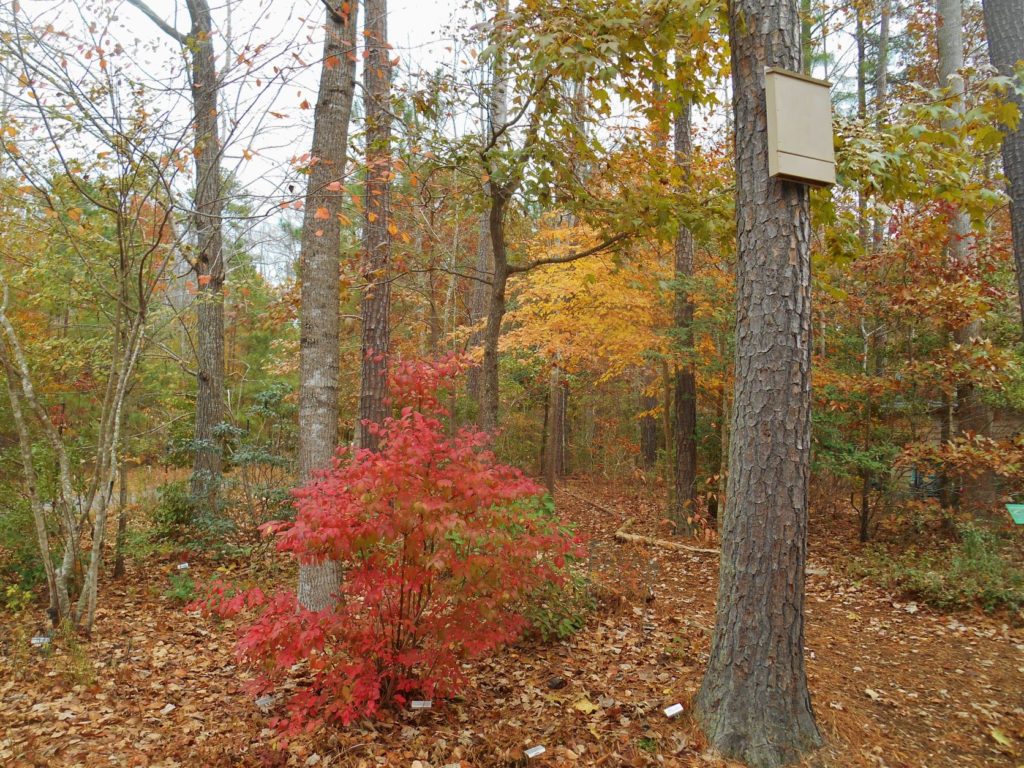
Trees turn bright colors each autumn at the Williamsburg Botanical Garden and Freedom Park Arboretum.
An Incalculable Loss
Too often, local government planners allow clear cutting on public and private forested land to build new roads, neighborhoods, or businesses. We see that continually here in the Williamsburg area. We have lost thousands and thousands of trees in recent years to road widening and development. We’ve also lost thousands of trees in recent storms, to disease, and to erosion along our waterways. We lose quality of life as our forested communities and roads lose their shaded appeal.
This is nothing new. Humans have been clearing land and harvesting trees for thousands of years. Wildfires, storms, pests and disease have claimed trees for centuries. We suspect that deforestation led to the historic collapse of several cultures, especially those on islands and peninsulas.
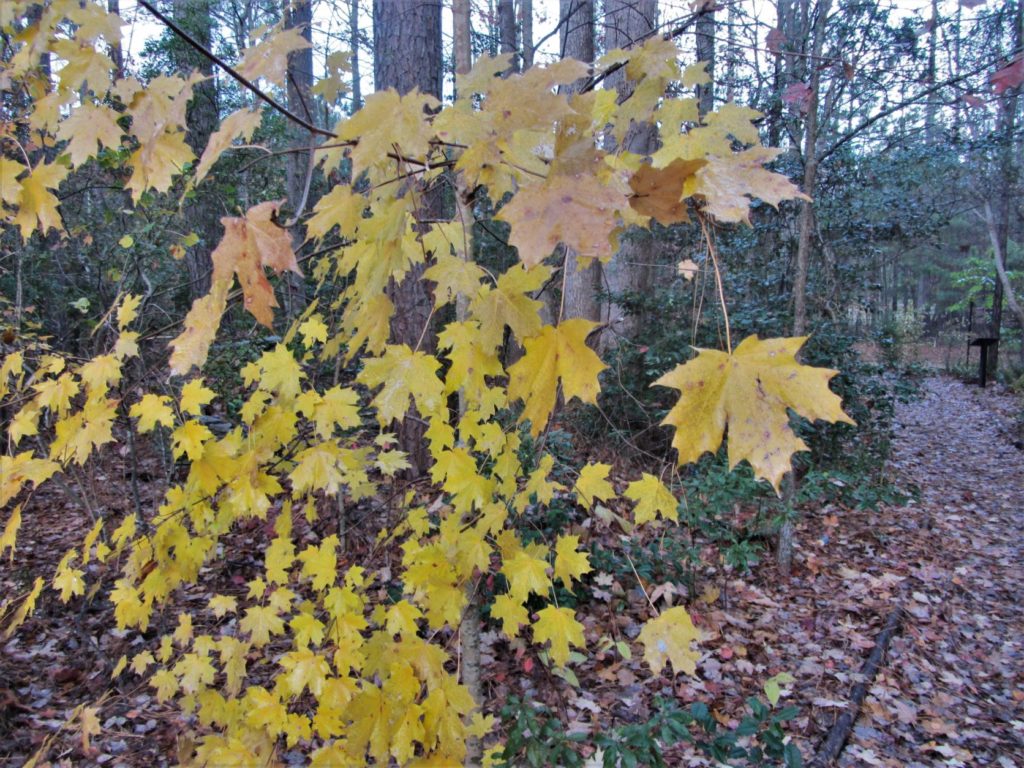
Acer floridanum, Southern sugar maple, is another keystone species found in the Williamsburg Botanical Garden and Freedom Park Arboretum.
Preserving Our Planet
Climate changes in response to trees. Trees moderate temperatures and protect the land from strong winds and driving rain. Their roots help hold soil against erosion during storms. Stormwater run-off is filtered, and pure water vapor returned to the air, as it moves from roots to leaves and back into the clouds.
Mature trees and shrubs filter and sequester hundreds of pounds of carbon from the air each year. The carbon is converted to cellulose and other compounds stored in the trunk, branches, leaves and roots of trees. ‘Heat islands’ form in city centers and along interstate highways where trees are cut and not replaced. As the area warms, rain goes elsewhere, and the land grows too dry to support crops and human communities.
Planting trees and restoring forests lost to fires, development and agriculture makes a significant impact in how much carbon hangs in the air, trapping heat and raising global temperatures. Each of us can make a positive difference for ourselves and our children through planting trees near our homes and in the larger community. Even when we don’t have space to plant a tree, we can donate to organizations, like the Arbor Day Foundation, devoted to restoring forests.

Black cherry, Prunus serotina, hosts hundreds of species of butterflies and moths, feeds native bees, and produces edible fruit
Planting for the Future
The first recorded Arbor Day festival and tree planting celebration occurred in Spain in 1594. Modern day Spanish tree planting festivals began in 1805. While war raged in Europe, a local priest organized the festival and “drafted a manifesto in defense of the trees.” It was sent to other villages, along with encouragement to plant trees for the benefit of the community.
Today Arbor Day is celebrated in all 50 states and has grown into an international, secular holiday to raise awareness about the importance of trees in our lives. Neighbors still come together to plant trees and reflect on their importance and benefits. The date of celebrations varies by country, depending on the best time of year to plant new trees in each climate. Arbor Day celebrations occur the last Friday of April in much of the United States.
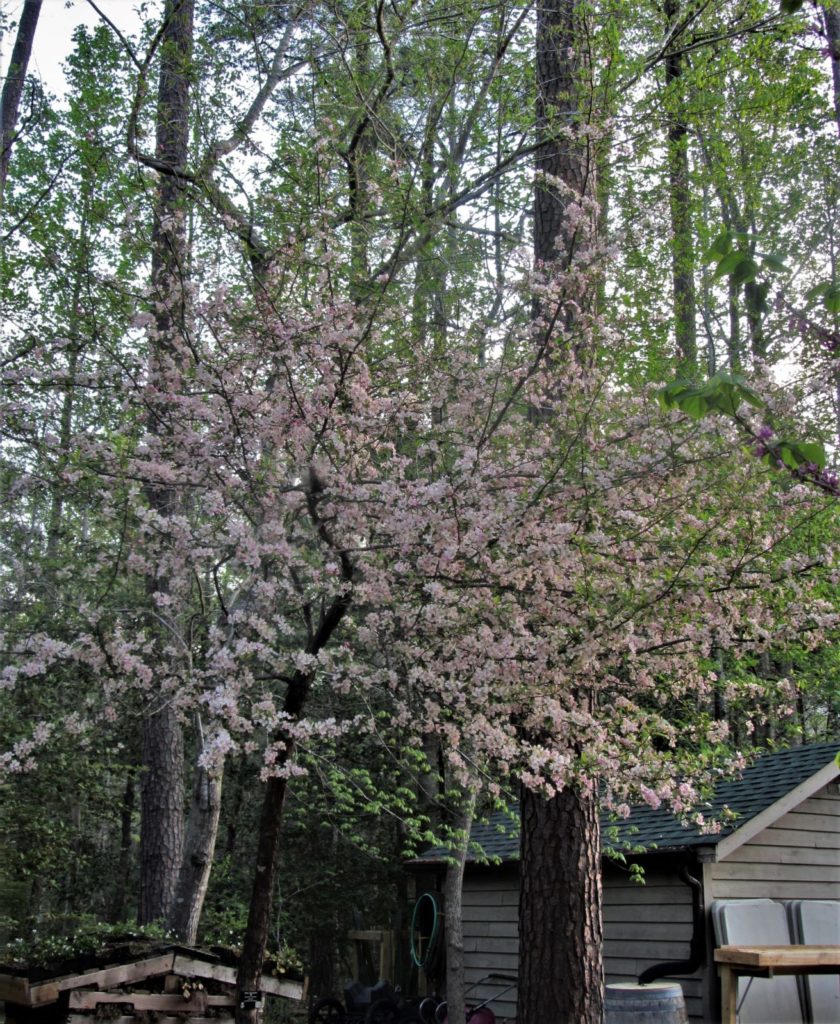
Bees cover a native crab apple, Malus angustifolia, when it blooms each April in the Williamsburg Botanical Garden.
In our area, the Williamsburg Council of Garden Clubs and local governments hold an Arbor Day celebration each March. Awards are given to individuals, businesses, and other groups who have made a positive impact in the community through landscaping and preservation of trees. Trees are planted by the Council each year as part of this community celebration. During the 37th annual Arbor Day Celebration this past March, held in cooperation with York County, two native red maple trees were planted in Yorktown.
Most of our holidays commemorate some event from the past. Arbor Day invites us to invest in a better, more beautiful future for ourselves and our community. Each tree we plant brings us closer to our goals of preserving planet Earth for future generations.
Further Resources:
Darke, Rick and Douglas Tallamy. The Living Landscape: Designing for Beauty and Biodiversity in the Home Garden. 2014.
Lambe, Dan. Now Is the Time for Trees: Make an Impact by Planting the Earth’s Most Valuable Resource. 2022.
Tallamy, Douglas. Bringing Nature Home: How Native Plants Sustain Wildlife in Our Gardens. 2007.
Tallamy, Douglas. Nature’s Best Hope: A New Approach to Conservation That Starts in Your Yard. 2020.
Tallamy, Douglas. The Nature of Oaks: The Rich Ecology of Our Most Essential Native Trees. 2021.
18 Reasons Trees are Good for Our Health
Forest Bathing from Healing Forest
How Trees Improve Your Mental Health from Chicago Gateway Green
These Keystone genera serve as hosts for 90% of Lepidoptera larvae, and they also provide nectar and pollen for specialist bees in our Eastern Temperate Forest region. The number of North American species listed is based on research completed in 2005 and more species may have been added. Find more information
Keystone Woody Genera
Pinus – Pine 203 species
Acer – Maple 285 species
Salix – Willow 456 species
Betula – Birch 413 species
Quercus – Oak 534 species
Carya – Hickory 200 species
Populus – Poplar 368 species
Malus – Crabapple 311 species
Prunus – Cherry, Plum 456 species
Vaccinium – Blueberry, Cranberry 288 species
All Photos by E. L. McCoy



